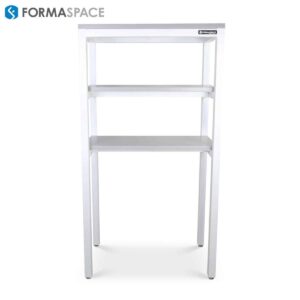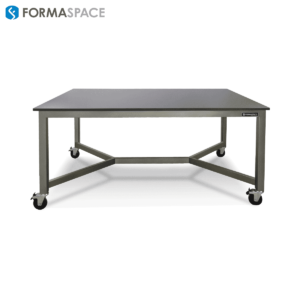Formaspace Uses Advanced Software Technology to Build Custom Industrial Workbenches
In an article in September, we talked about how Formaspace utilizes Autodesk Revit software when clients request custom-made technical furniture, like custom industrial workbenches, computer workstations or packing tables for distribution centers. Revit is particularly suited for the development of new furniture concepts because the CAD workflow facilitates the rapid creation of 3D renderings (images) of highly customized technical furniture prototypes. These renderings are an important step in the customer approval process before committing to manufacturing. This modern manufacture workflow at Formaspace is just one example of how advanced technology is transforming manufacturing. Today we will kick off a three-part series looking at a set of technologies collectively known as “additive manufacturing” which was the subject of an industry leaders’ panel discussion at last week’s WestTec convention in Los Angeles.
Additive Manufacturing Technology: A Three Part Series
Today in Part 1 we will look at the business case of additive manufacturing and 3D printing from the point of view of existing manufacturers:
- Could 3D printing change the conventional manufacturing business model?
- Realistically speaking, what are the present-day capabilities of 3D printing/additive manufacturing?
- How can these techniques be used in the future?
In Part 2 we will look at what effect additive manufacturing technology might have on the manufacturing industry’s current business model if it was widely adopted by consumers. According to some very enthusiastic proponents, additive manufacturing is poised to completely disrupt the current manufacturing business model. We’ll evaluate these sensational arguments in the second article of this series. Finally, in Part 3, we’ll look at the potential legal, ethical and environmental consequences of a establishing a widely distributed network of additive manufacturing sites. These complex issue range from the controversies surrounding ‘printing’ a plastic hand gun, to protecting intellectual property and consumer protection issues, such as when someone makes copies of a trademarked design or establishing who is responsible if a defective product causes an injury.
Could Additive Manufacturing like 3D Printing Change the Conventional Manufacturing Business Model?
3D printing and other related technologies have the potential to drive the cost of manufacturing short production runs down, way down. 3D printing can entirely bypass the time and expense required to build conventional short production run tooling, such as soft aluminum molds for plastic injection parts, flexible molds for casting duplicate parts or lost wax techniques for producing metal parts. Why? By its very nature, 3D printing does not require much in the way of tooling, aside from simple armatures supporting the weight of heavier items. (While these armatures often end up looking like the ‘sprues’ used in castings or injection molded parts, armatures are typically printed by the print head just like the rest of the object.) If the short production runs cost less, then it becomes more economical to produce multiple variations of existing products to satisfy customers demand. This in turn could to a revolution in “long tail” niche manufacturing.
Long Tail Niche Manufacturing
We’ve already experienced the “long tail” revolution in a related sector — the online retail market. Powerful internet search technologies have enabled online retailers to offer a mind boggling array of goods for sale, often at very low volumes. This approach is called the ‘long tail’ business model for the “L” shaped volume curve. It’s enabled savvy retailers to match or exceed the profits from the more traditional product “blockbuster” approach of selling just a few products at massive volumes. The long tail model is effective for online retailers because low volume products can be stored in warehouses without the added cost of displaying or transporting them until they are sold.
‘Print on Demand’
Now additive manufacturing could help manufacturers bring about a similar “long tail” revolution in niche manufacturing by taking this one step further: instead of stocking thousands of products, 3D printing could allow manufacturers to ‘print’ and deliver a product on demand in one step, avoiding the capital costs associated with stocking a vast variety of goods in a warehouse.
Does Reality of Additive Manufacturing Match the Hype?
Early applications of 3D printer and related additive manufacturing technologies were limited to appearance prototypes. In the beginning, even these were fairly limited, due to poor surface quality. But over time materials have improved, allowing production of functional prototypes that incorporate working features, like living hinges. Continuous breakthroughs in materials properties and surface quality have driven rapid growth.
For example, 3D printing systems from the Object (now part of Minneapolis-based Stratasys) can print a single object that incorporates up to 14 different materials selected from an inventory of over 100 materials, ranging from hard metal surfaces, soft and flexible plastic surfaces or stiff but resilient rubber-like surfaces. These advances have helped transition the market from its early prototype-only output to full-fledged part production; according to the 2013 Wohlers Report (Wohlers Associates, Inc.), direct part production (real parts, not prototypes) now accounts for 28.3% of the total product and services revenues from additive manufacturing world-wide.
The Future is Now: New Tools Provide Innovative Ways of Working
Production statistics alone don’t capture the excitement and inspiration that additive manufacturing has brought to the manufacturing community. Product Engineers have taken advantage of these new techniques to create product designs which where the stuff of science fiction only a few years ago. For example, engineers can develop products that would be impossible to assemble using conventional methods. Take a classic novelty item, the ‘ship in a bottle’, as an analogy. Conventional manufacturing requires tricky methods to get that ship inside the bottle, often by rigging tiny hidden folding mechanisms allowing the ship model to enter the mouth of the glass bottle where the ship model is ‘unfurled’.
Now take this ship model and imagine it’s a ball valve inside a pump. In traditional manufacturing, the housing of the valve has to include an opening to insert the ball, then more structure to secure the opening once it’s closed, probably including an additional fastener to make sure the opening stays shut. In additive manufacturing, the housing could be built around the ball, providing a lighter one piece structure in one piece. Additive manufacturing also lends itself to working with powerful data acquisition methods, such as 3D Scanners. We conclude our first article on Additive Manufacturing with a medical case study by Dallas-based technology visionary Nancy Hairston. In a recent Ted Talk, Nancy presents an additive manufacturing case study showing how her firm MedCAD can use three dimensional data acquired via a CAT Scan to develop custom medical implants used in surgical hospitals.
http://www.youtube.com/watch?v=yAZ1v0n5_ng








